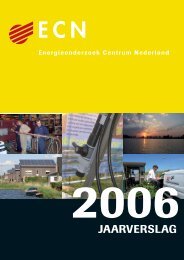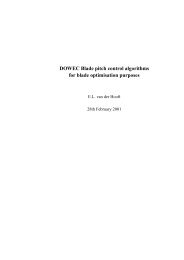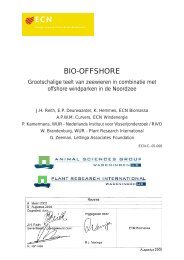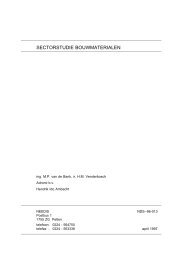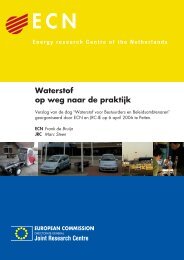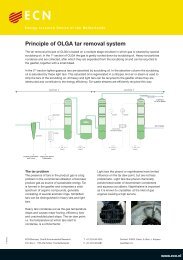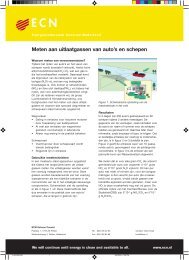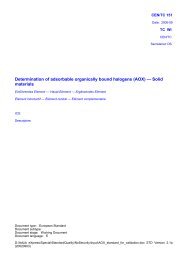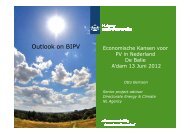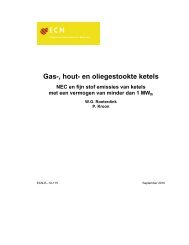PDF format (503 kB) - ECN
PDF format (503 kB) - ECN
PDF format (503 kB) - ECN
Create successful ePaper yourself
Turn your PDF publications into a flip-book with our unique Google optimized e-Paper software.
or keep it fresh and their second concern is related to marketing considerations. Material efficiency improvement<br />
is only attractive if it saves money. Fortunately, the cost of packaging is for a substantial part related to<br />
the material input. Therefore some measures are likely to be implemented voluntarily like weight reduction of<br />
steel and aluminum cans and plastic and glass bottles.<br />
From current European policy as stated in the Packaging Directive we may expect that the goals are reached at<br />
some point in the future. The goals as stated in the packaging directive (e.g. 25-45% recycling of packaging<br />
waste [EU, 1994]) are not very likely to reach a 50% CO2 reduction before 2020. The second Packaging Covenant<br />
in The Netherlands goes further than the European directive. It aims for a total reduction of the amount of<br />
packaging waste to 940 ktonnes in 2000 compared to 1314 ktonnes in 1995, or a reduction of 28%. For the<br />
different packaging materials sub-covenants have been made for more detailed goals per material. Even though<br />
large waste savings may be the result of this covenant, a reduction in CO2 emissions with a factor 2 is not likely<br />
to be the result.<br />
In order to reach CO2 emission reductions with a factor 2 or more in the field of packaging and to use the potential<br />
of available options a more stringent policy is needed. It is not within the scope of this paper to argue for<br />
special measures or even to indicate where to focus on. However, it seems that the effects of 'factor 2' policy on<br />
the packaging industry in The Netherlands will not be as great compared to the average European situation.<br />
This is mainly due to the fact that in The Netherlands the use of returnable packaging is much more common<br />
than in other parts of Europe. Furthermore it is very likely that 'factor 2' policy will not affect the packaging<br />
industry as much as the materials producing industries. The packaging industry will use their innovative<br />
strength to produce different packaging products (as became visible in The Netherlands during packaging<br />
covenant I) but the plastics, paper and board and the iron and steel industries will be forced to produce less than<br />
before. However, the production high value added products (e.g. ultra thin steel, high tech foils) may weaken<br />
this trend.<br />
7 Conclusions<br />
The packaging sector is an important sector from a material consumption point of view. The sector is responsible<br />
for about 3.3 percent of the European CO2 emission. The most important materials used in this sector in<br />
terms of CO2 emission are plastics, metal and paper and board.<br />
The use of packaging materials is closely related to the use of consumer goods. The latter is likely to go through<br />
a strong growth the coming decades and therefore a growth in packaging consumption may be expected. Even<br />
though European policy by means of the Packaging Directive is aiming at increasing the recycling targets a net<br />
increase of virgin packaging materials may be expected.<br />
Many options are available to reduce the amount of packaging material. This paper shows that these options<br />
may lead on first sight to a reduction of CO2 emission by the packaging sector with at least a factor 2 by the<br />
year 2020. The options will de used as input data for the MARKAL model in order to calculate the total CO2<br />
emission reduction possible.<br />
The options dealt within this paper are specified per packaging category and by packed product category. However,<br />
in general the options can be classified by four categories: lighter (more efficient) packaging, reusable<br />
packaging, material substitution and use of recycled material.<br />
Making more efficient use of packaging materials often leads to cost effective savings of 10 - 20% packaging<br />
material. The use of reusable packaging has great potentials. Returnable or reusable pallets, crates and PET<br />
bottles have trip numbers varying from 5 to 100 trips which has large effects on the amount of packaging material<br />
needed per packaging service. The influence of material substitution on CO2 emissions is not clear. The<br />
MARKAL model should create more insight in this matter. The use of recycled materials is in some parts of the<br />
sector (industrial transport) very promising and in others it is more problematic (food packaging).



